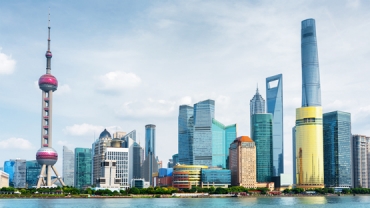
Rethinking supply chains after China’s lockdown
07 July, 2022
Before 2019, supply chains were a dull affair, even if sanctions between the US and China had to be adhered to. Times have changed. In 2022, the issue is very much at the top of almost every CEO’s risk list.
Business leaders around the world must now deal with the supply chain interruptions resulting from China’s lockdown. They must also consider the long-term implications.

In 2021, China declared victory over the pandemic within its borders. Since then, it has been keeping its frontiers hermetically sealed and ruthlessly fighting even the smallest occurrence of the coronavirus. This worked well until the Omicron variant emerged. Now, the country’s draconian controls have proven ineffective in preventing the virus from spreading within mainland China.
Up to one-third of the
population in lockdown
Shanghai, China’s most international city, experienced new cases of Covid and was closed down as a result. The city went into a partial five-day lockdown on March 28, which became a city-wide lockdown on April 5. When this article was written in late May 2022, the city-wide lockdown was still in place.
A total of 43 major cities, which together account for a third of China’s population, were in lockdown as of mid-May 2022. Under these circumstances, the forecast GDP growth of 5.5 percent will not be achieved this year; a maximum of around 4 percent is now expected.
Transport – a national challenge
The Chinese government is willing to sacrifice a substantial part of the economy to maintain its current pandemic policy. It is doing so to protect its citizens, who would face an overwhelming wave of 125 million infections if Omicron were not contained. The victims would be mainly elderly individuals who have not been willing to be vaccinated. China’s health-care infrastructure would not be able to handle such an outbreak, despite the considerable progress made preparing hospitals with hard- and software for a pandemic.
While certain manufacturing locations in the locked-down regions have still been operating in a “closed-loop” process, in which the necessary workforce is housed on site, the transport of goods has become a nationwide hurdle to be overcome.

Only essential goods can be transported, and obtaining a permit is a cumbersome process involving several government offices. Such a procedure is lengthy and complicated in normal times, but the lockdown has made it much more difficult.
Transporting goods across provincial borders is also a challenge, and it took a decision from Beijing to prevent shipments from being stopped at provincial borders. However, the various officials who carry out the control stops on the ground interpret the applicable regulations differently and may require documentation that cannot be obtained or refuse papers that have become outdated since the vehicle departed from its original location.
For European-based investors, China will not be accessible for three years or more as quarantine-free travel is only expected from spring 2023. Considering that executives serve as CEO for three to five years on average before moving to another position, we will soon have a generation of top executives who have not seen or experienced China. They will not have met their China team in person at all or not for several years. That will result in much less understanding and willingness to focus on the People’s Republic; the management team would seek partners instead that can help in the China market, or alternatives to sourcing from China.
Paradigm shift ahead
Availability trumps cost advantages, and the ghost of inflation has been reappearing since winter 2021/22. In this case, inflation is being fueled by higher energy prices as well as transport costs, lack of containers, shipping delays, and increased inventories to buffer delays – in short, supply chain issues.
Is it time for a paradigm shift? Are corporations returning to vertical integration and building up inventories in order to increase their balance sheets? Is near-shoring the solution or will the response be something completely new?
Supply chain industry’s perfect storm
The time for fundamental, or should I say seismic, shifts may have come. With new EU legislation imposing a carbon tax on products sourced with the “wrong” raw materials, energy sources, transport or operations, the case for fundamental change will be debated at senior management and board level. It seems to be the supply chain industry’s perfect storm.
What might such a paradigm shift look like? Let me outline a hypothetical business model that I am sure some innovative entrepreneurs are looking at right now: 3D printing. This technology has matured and, in extreme cases, can produce up to 100,000 pieces more cost efficiently than mass production. As a result, it is now possible for car repair shops to lease 3D printers and use licensed technical drawings from car manufacturers to create spare parts. This will allow repair shops to print the defective part on site, which in turn will shorten repair times, eliminate inventory, reduce carbon footprints, etc.
How will this affect the ecosystem? Polymer suppliers will gain a new market segment, as they can serve new clients with smaller batch sizes, which usually also increases profit margins. The automotive and parts manufacturers will have lower inventories for spare parts and can reduce working capital and inventory costs. They can focus on the complex parts that are challenging for a 3D printer to produce. Logistics companies will have less volume to ship, and complexity in supply chains will be reduced as less border crossings take place. The car repair industry will be less dependent on spare parts and their logistics. The end consumer will have a better service experience.
I would not be surprised if such a model is rolled out. Dental clinics have been using such a system for several years to make crowns or teeth that meet their patients’ individual needs. Seismic shifts like the one outlined could also take place in other industries. It all depends on the lead time for implementation.
Loss of trust in China
With China stopping in-person business interactions until spring 2023, it will not be able to regain the trust it has lost as a stable, reliable supplier to the world. Workarounds have already been found for certain product categories. Some alternatives can be seen in Southeast Asian countries. As the example of Vietnam shows, a scale has been reached that is now becoming evident in the statistics: In March 2022, Vietnam’s export volume was higher than Shenzhen’s.
Products such as basic chemicals or active ingredients for the pharmaceutical industry are more difficult to relocate to other sites, but businesses will carefully analyze their investments in new plants. For example, new semiconductor manufacturing facilities are now being built outside of mainland China and even outside of Asia.
The longer the measures meant to control the pandemic in China remain in place, the more likely it is that a paradigm shift will be considered – and implemented.

Felix Sutter
Felix Sutter has served as the President of the Swiss–Chinese Chamber of Commerce (SCCC) since 2015. He was instrumental in repositioning SCCC and restructuring its Board. He was nominated in November 2017 as one of only three “Visiting Leaders” at the China European International Business School (CEIBS) Shanghai Campus. In October 2020, he founded SUCCEED Consulting GmbH with his Chinese partner, Sheng Bin. The company’s mission is to expand businesses by connecting innovative Swiss and Chinese firms, entrepreneurs, and investors. He was a Partner at PricewaterhouseCoopers (PwC) Switzerland for more than 19 years. After starting his corporate career in 1981 at insurance companies, he moved to PwC in 1995 and was with the firm until 2018.
Tel: +41 79 4052-785
Email








